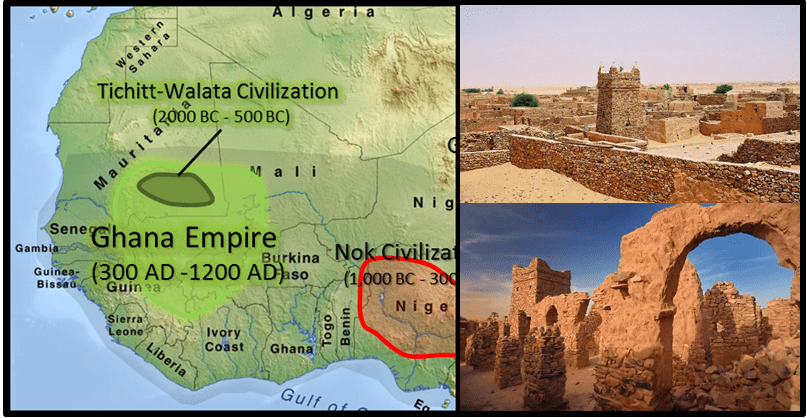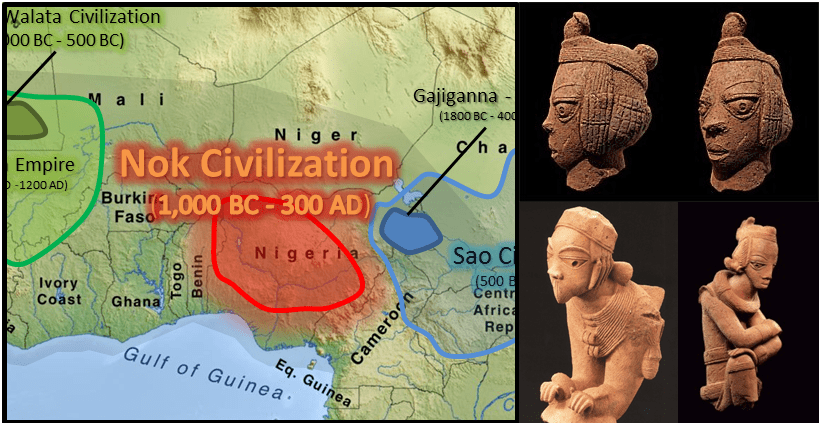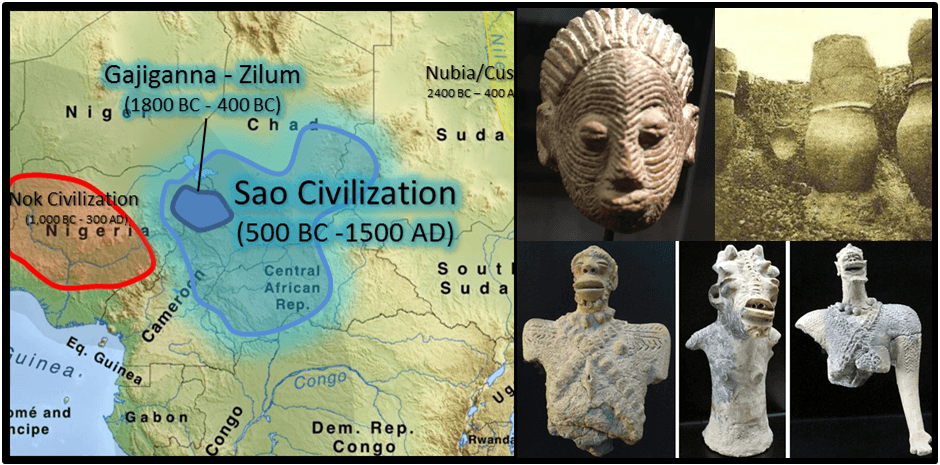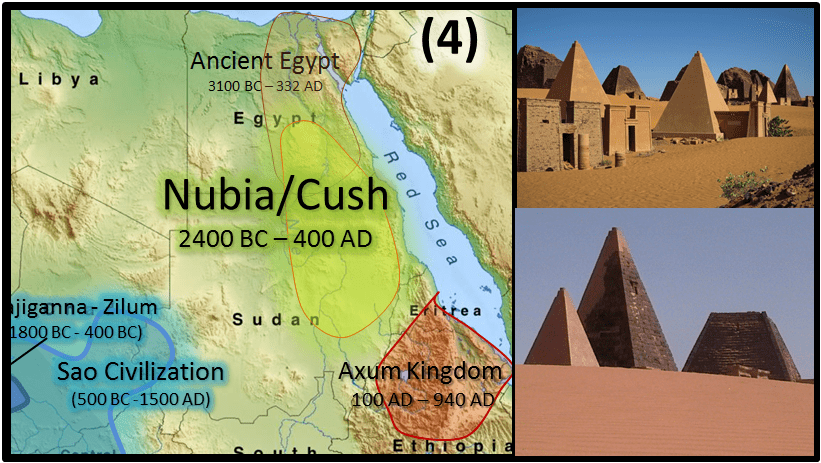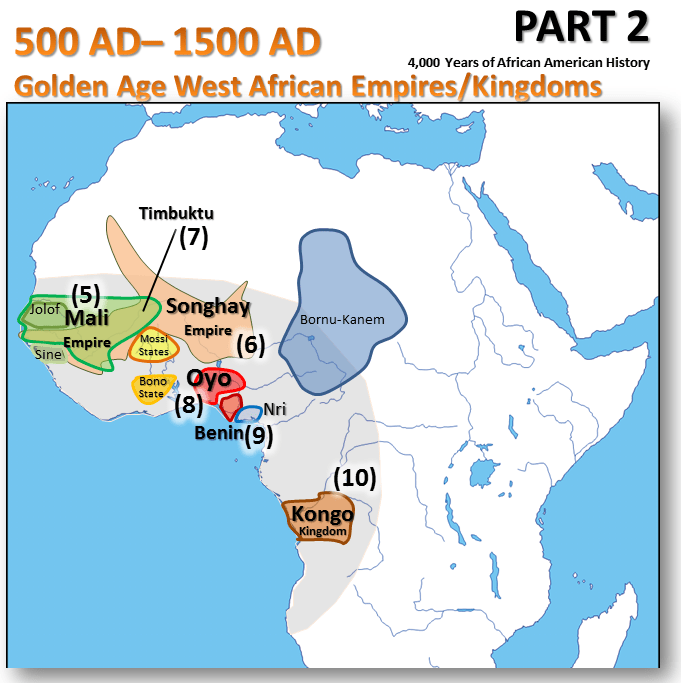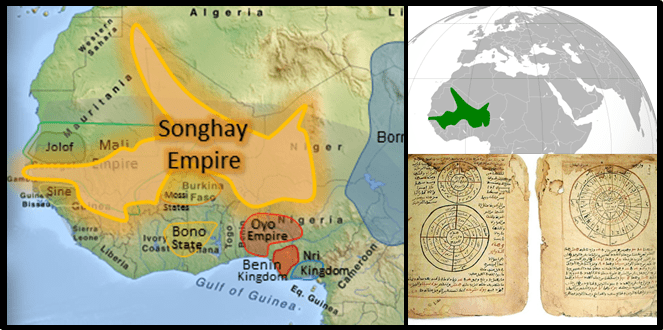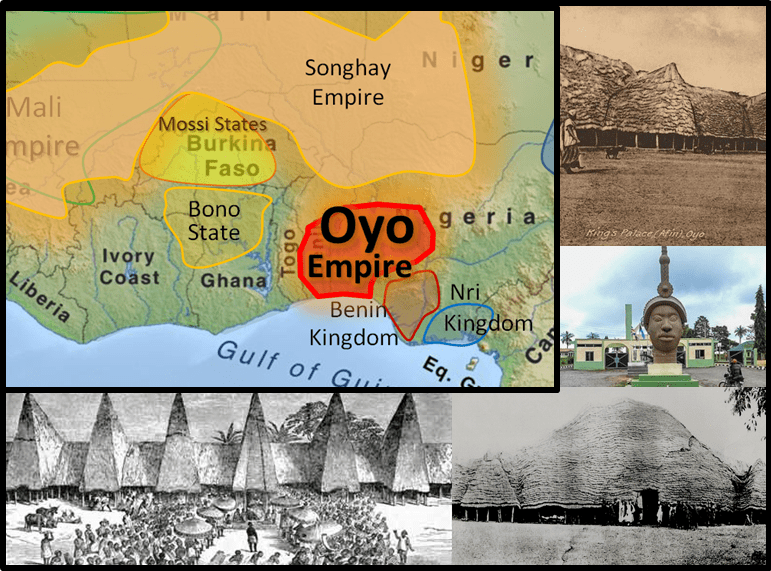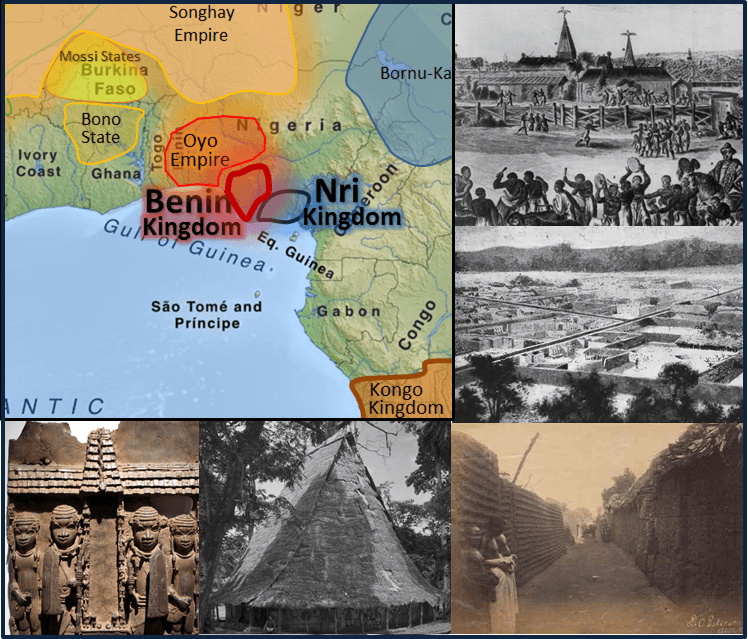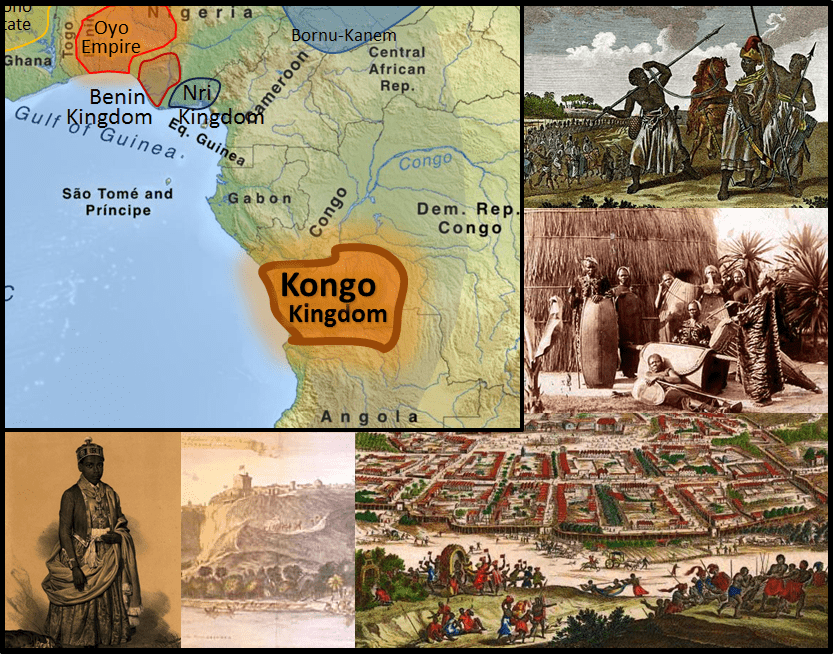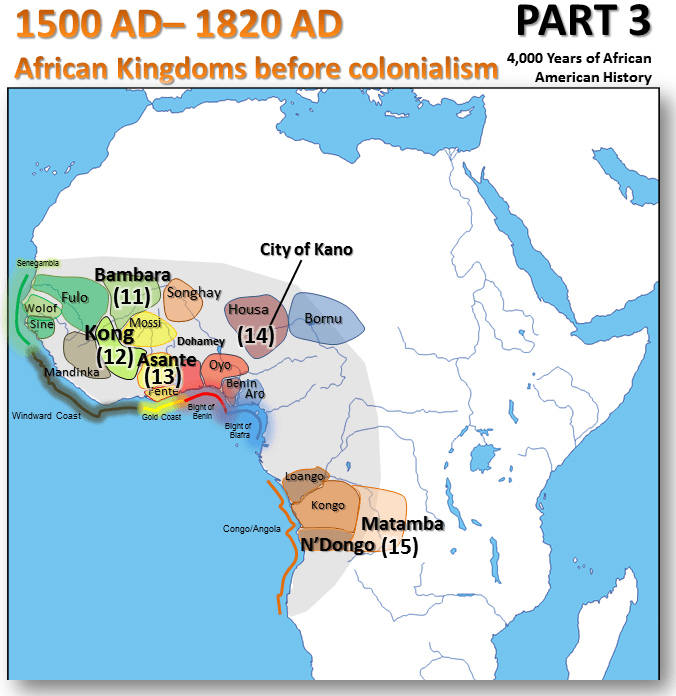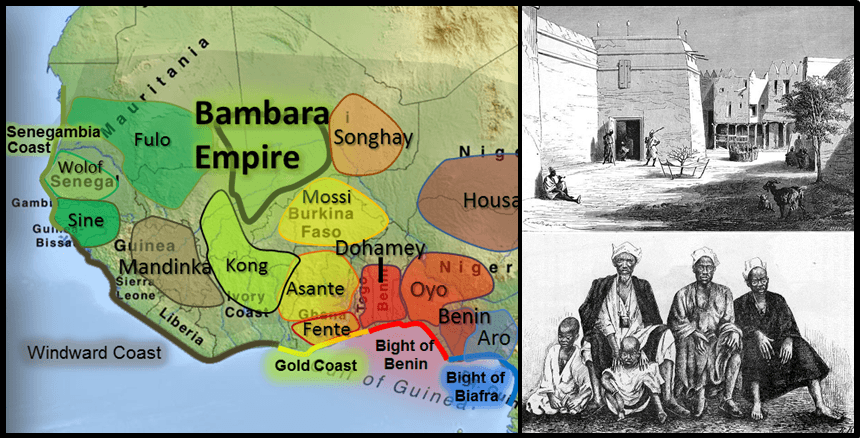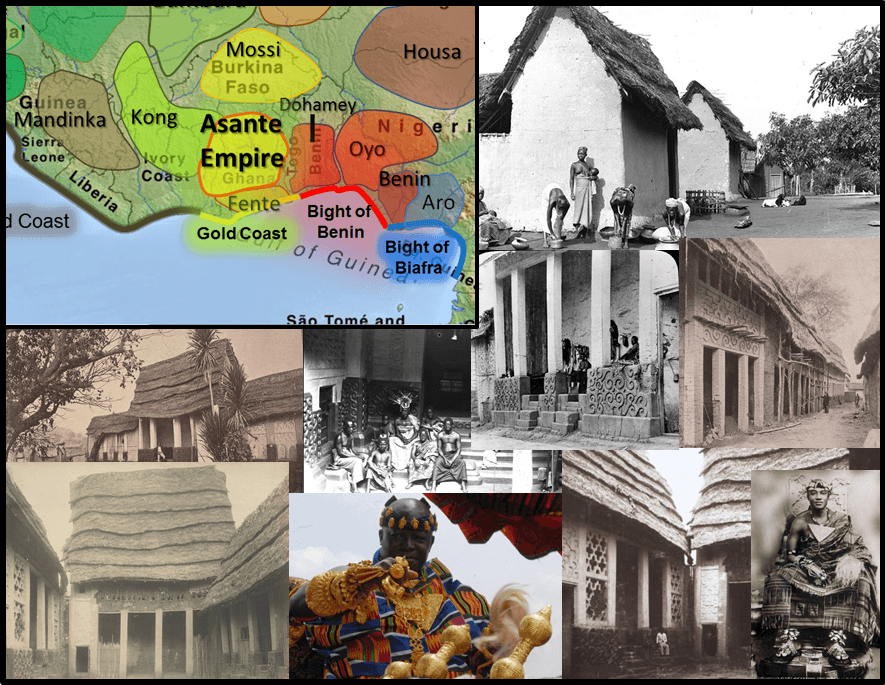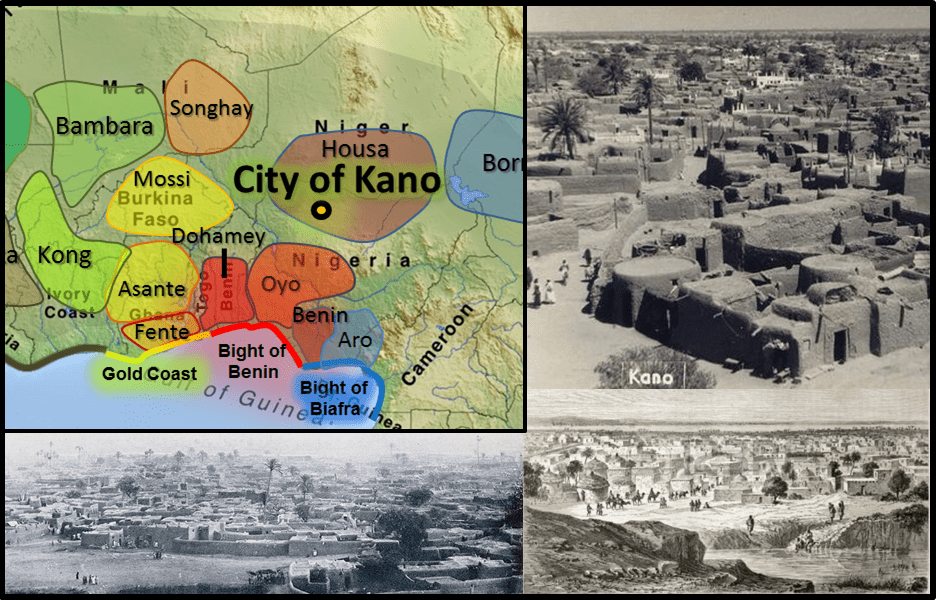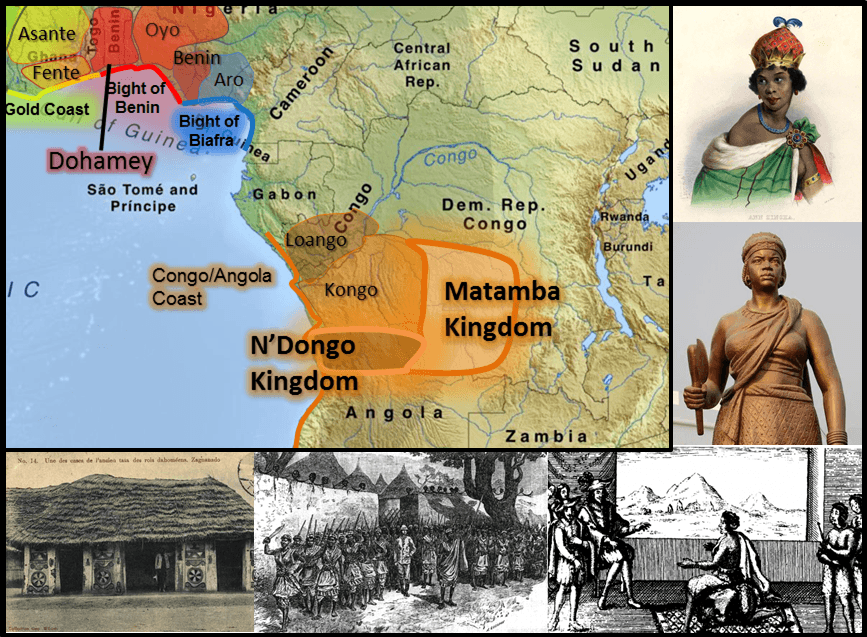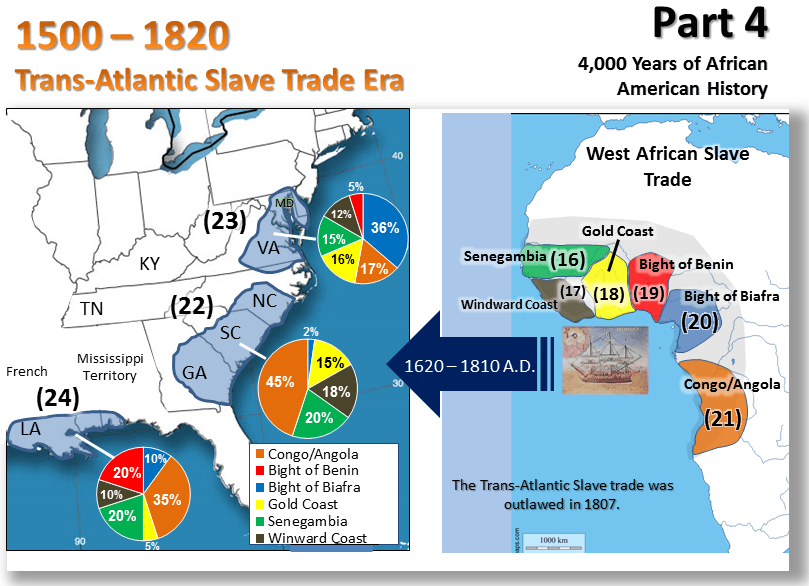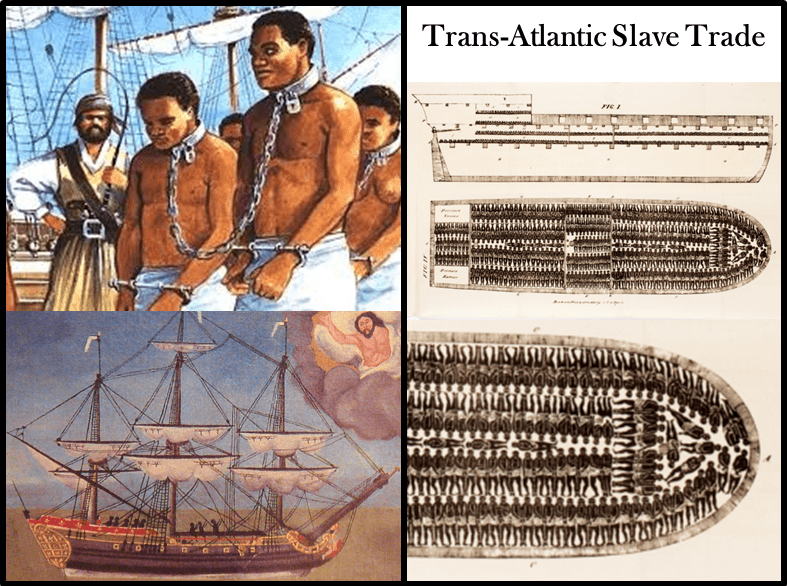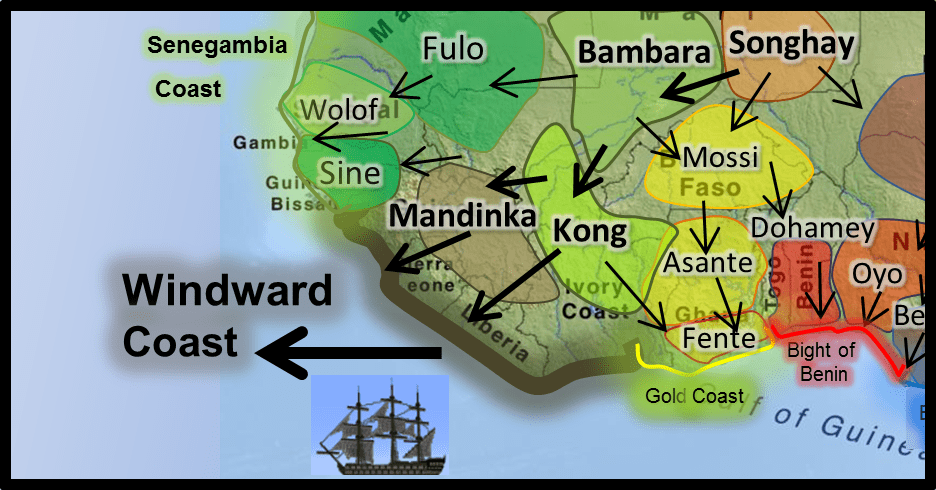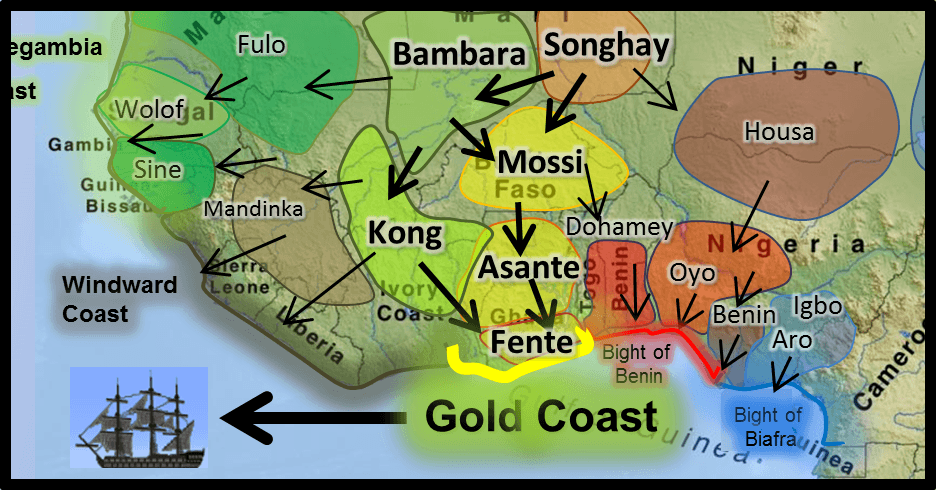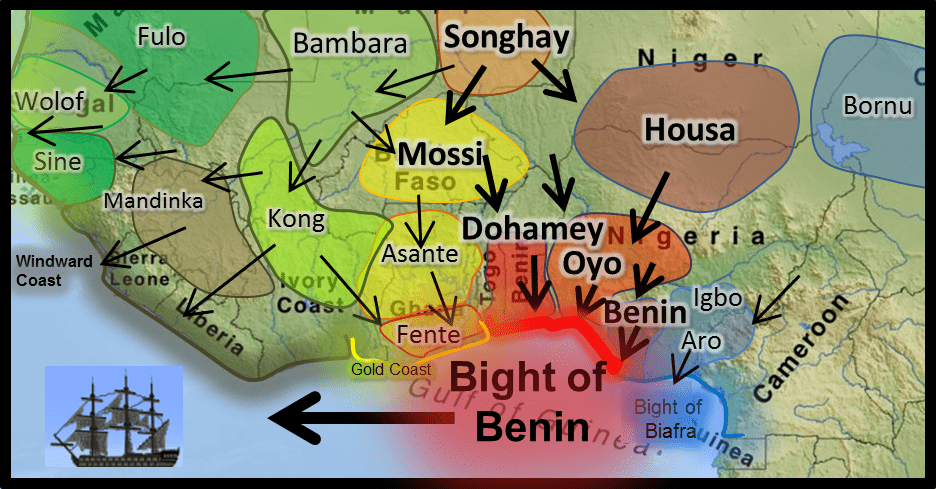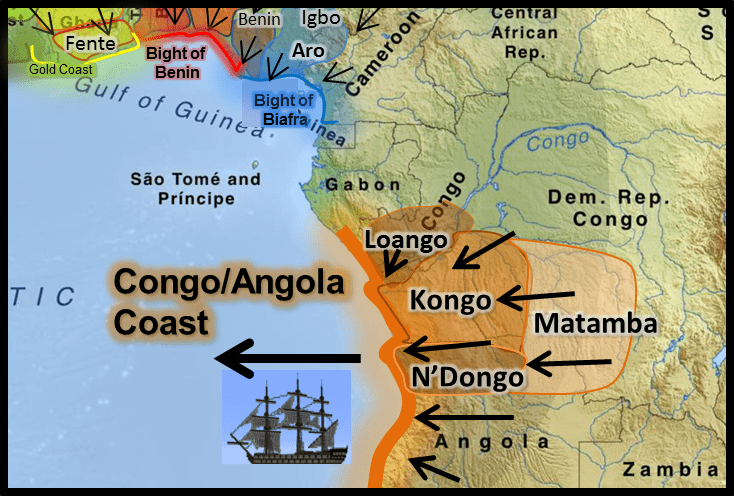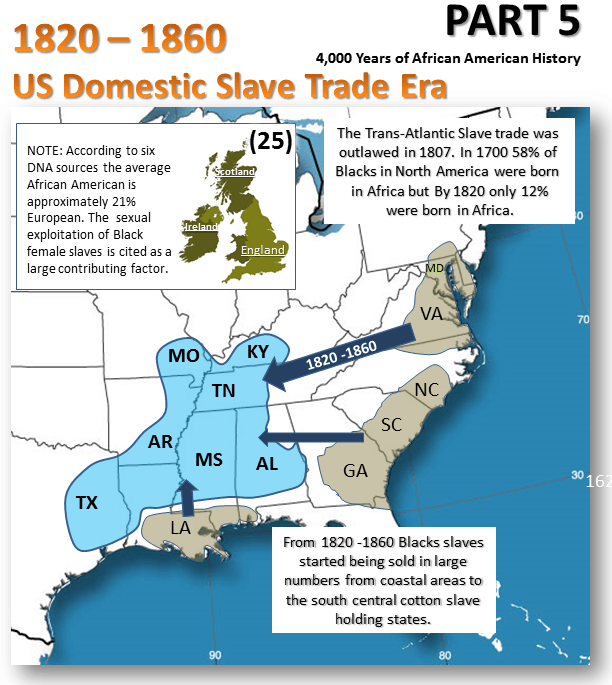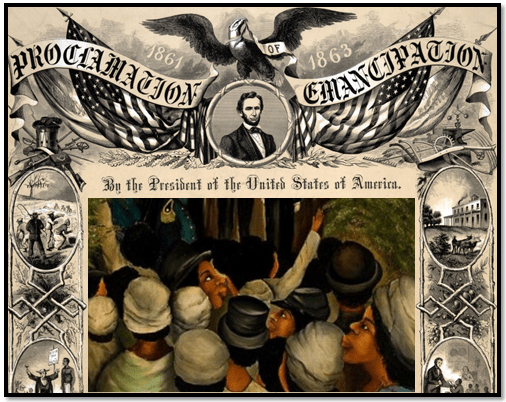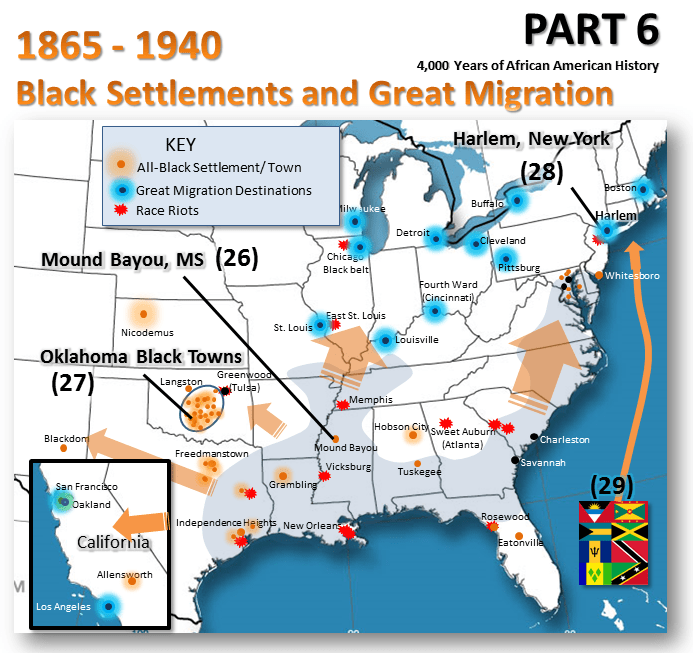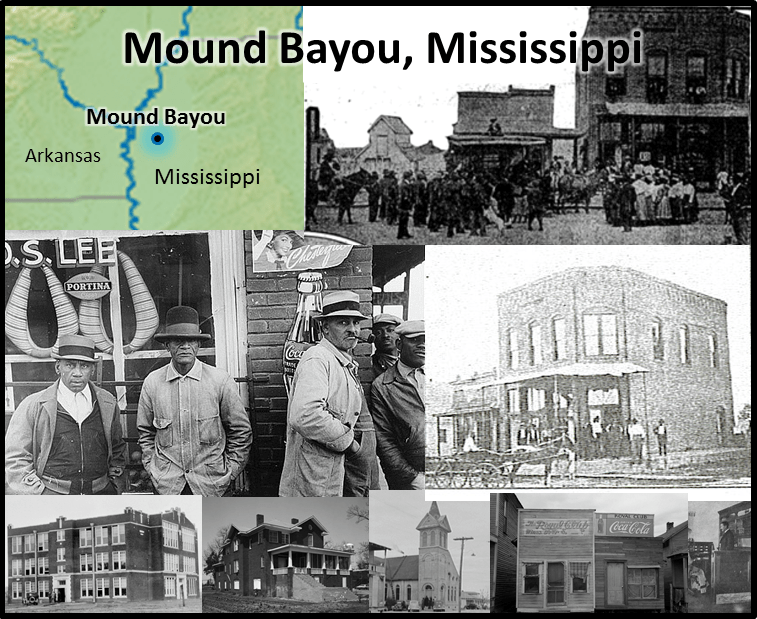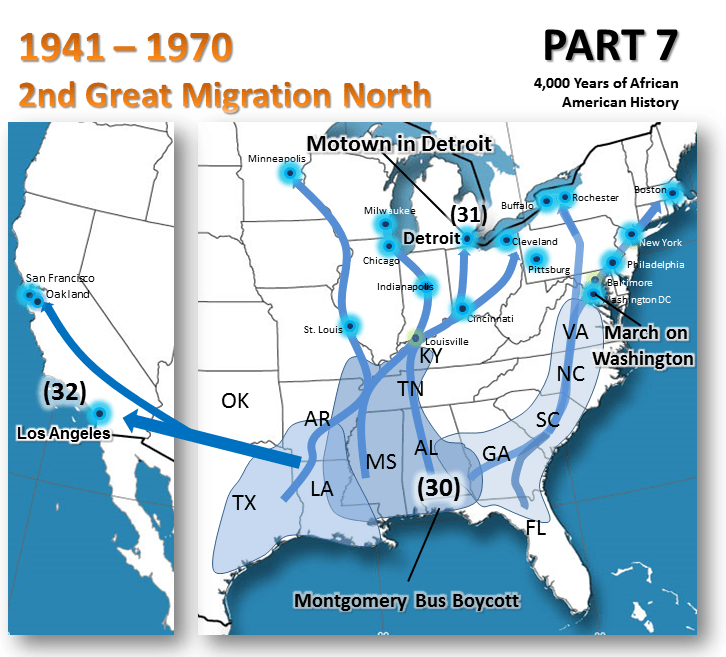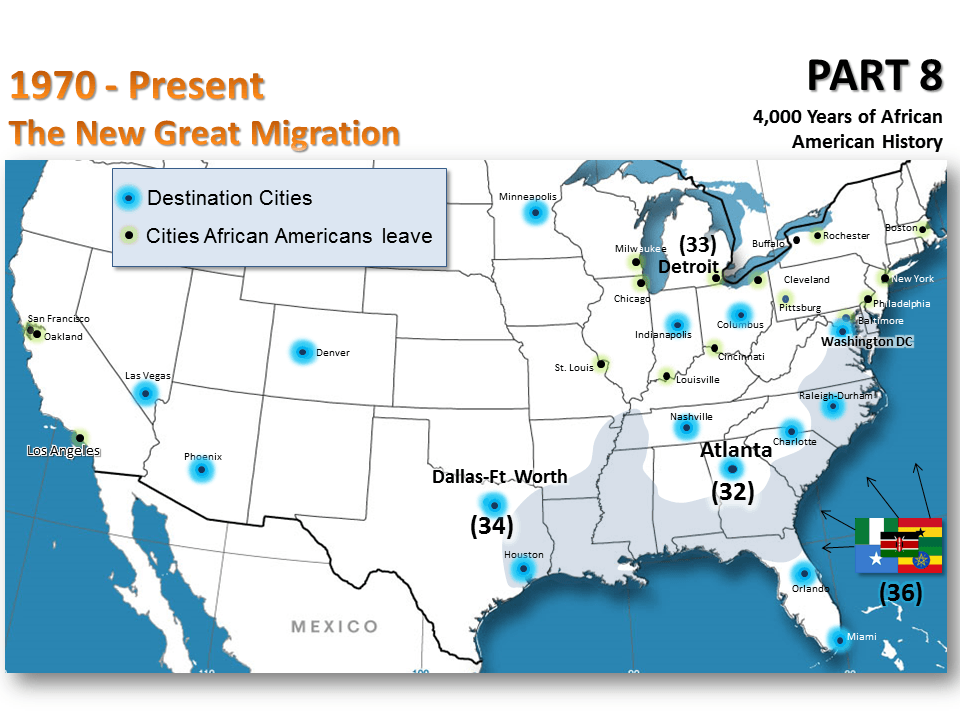4,000 Years, Not 400!
Most African Americans descend from the half million Africans who landed on the shores of North America as captives during the trans-Atlantic slave trade. The vast majority came from Western Africa (shaded area below) whose history is a story of the rise and fall of many kingdoms and empires. In this one post we will journey through a largely untold history of African Americans from 2000 BC to 2000 AD.
PART 1
2000 BC to 500 AD
Ancient Africa
CLICK IMAGE TO ZOOM
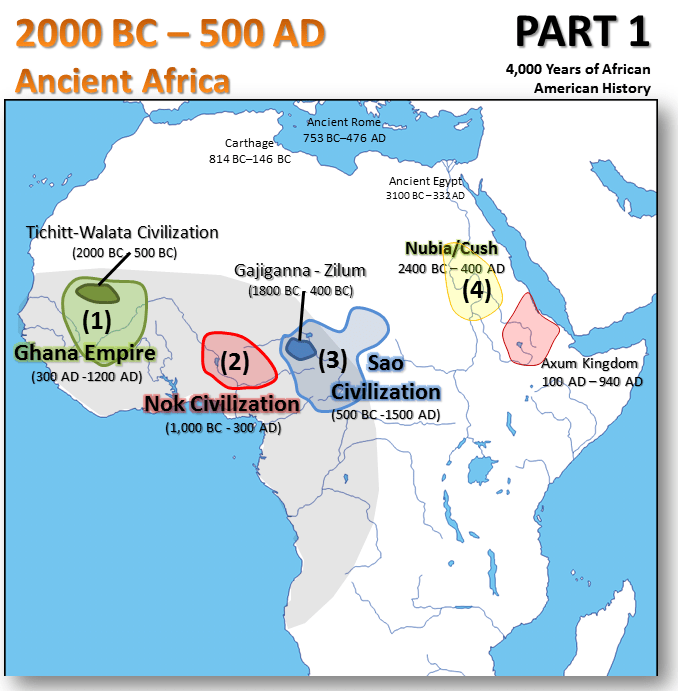
The shaded area of Western Africa where most African American ancestors came from shows evidence of civilizations that go back to at least 2000 BC.
The descriptions in the parentheses (0) match the images on the map.
(1) Ancient Ghana Empire
In West Africa hundreds of abandoned stone settlements dating back to 2000 BC have been found near Tichitt and Walata (2000 BC-500 BC) in an area that later became part of the Ancient Ghana Empire (300 AD – 1200 AD) in present day southern Mauritania and western Mali which ruled for 900 years from the capital city of Koumbi Selah (pictured above).
(2) Ancient Nok Civilization
The Nok Civilization (1000 BC – 300 AD) in present day Nigeria is believed to have started around 1000 BC. Excavations have found close to one hundred Nok settlements revealing terracotta sculptures from 500 BC (pictured above), pottery, and evidence of large iron furnaces also dating back to at least 500 BC.
(3) Ancient Sao Civilization
Evidence of the Sao Civilization (500 BC-1500 AD) in present day eastern Nigeria, southern Chad, and northern Cameroon, near Lake Chad has traced its history to around 300 BC based on the discovery of pottery and terracotta sculptures (pictured above) at several sites in the area. Some burial grounds show people buried in the fetal position inside large jars (pictured above) similar to some burial sites in Egypt. New excavations from the region of the Sao have revealed evidence of an even earlier civilization referred to by archaeologists as the Gajiganna – Zilum Complex dating back to at least 1800 BC.
(4) Ancient Kingdom of Nubia
In northeastern Africa the ancient African Kingdom of Nubia (present day Sudan) actually goes back before 2000 BC. Nubia, also known as Cush, built more – albeit smaller – pyramids (pictured above) than Egypt, and eventually conquered and ruled Egypt during its 25th Dynasty (760 BC–656 BC). Although this area is not located in western Africa, some suggest archaeological evidence and written Egyptian records could prove that ties existed between Ancient Egypt, Nubia, and the Sao/Gajiganna – Zilum Civilizations.
In Summary
The Western African civilizations of Tichitt and Walata, Nok, Sao, Gajiganna – Zilum, and the Ghana Empire were all located in the section of Africa where most African Americans would eventually come from (shaded area of map).
PART 2:
500 AD to 1500 AD
The Golden Age of West Africa
While Europe descended into its “Dark Age” after the fall of the Roman Empire, West Africa was ascending into what many consider to be its Golden Age. The following are a few highlights about this period.
The descriptions in the parentheses (0) match the images on the map.
(5) Mali Empire Mansa Musa was the 10th king of the Mali Empire (1200-1670) and has been named the richest person ever in the world by Time Magazine (July 30, 2015). He was mostly remembered for his wealth in gold made famous by his pilgrimage to Mecca. While travelling through Egypt on the way to Mecca his caravan spent so much gold it deflated gold prices in Egypt for the next 10 years.
Mansa Musa was the 10th king of the Mali Empire (1200-1670) and has been named the richest person ever in the world by Time Magazine (July 30, 2015). He was mostly remembered for his wealth in gold made famous by his pilgrimage to Mecca. While travelling through Egypt on the way to Mecca his caravan spent so much gold it deflated gold prices in Egypt for the next 10 years.
Mansa Musa appears on a Spanish map (above) made in the year 1325 holding a large gold nugget. This is believed to be why European interest in the rich African continent grew. It would be another 100 years before European ships arrived on the West African coast. The Mali empire consisted of the former Ghana Empire and westward including present day Senegal and Gambia.
(6) Songhay Empire
Sunni Ali Ber was the first King of the Songhay Empire (1375 – 1591 AD) as he seized control of former Mali strongholds using his powerful military. Songhay eventually became the largest empire in pre-colonial West Africa encompassing most of the former Ghana and Mali Empires and eastward including present day western Niger.
(7) City of Timbuktu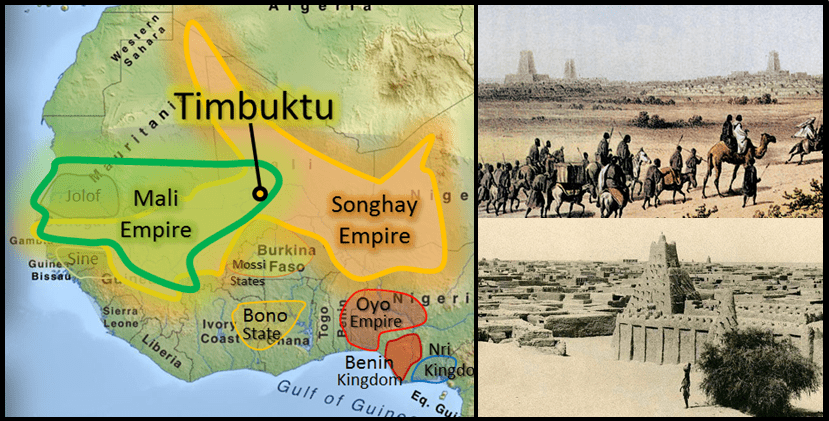 The city of Timbuktu was an important center of commerce and education during the Mali and Songhay Empires. Timbuktu was the location of the University of Sankore founded in 988 AD (pictured above) which was famous throughout the Muslim world. National Geographic estimates that 700,000 manuscripts which are hundreds of years old have survived in present day private libraries in Timbuktu calling them “significant repositories of scholarly production in West Africa and the Sahara”.
The city of Timbuktu was an important center of commerce and education during the Mali and Songhay Empires. Timbuktu was the location of the University of Sankore founded in 988 AD (pictured above) which was famous throughout the Muslim world. National Geographic estimates that 700,000 manuscripts which are hundreds of years old have survived in present day private libraries in Timbuktu calling them “significant repositories of scholarly production in West Africa and the Sahara”.
(8) The Oyo Empire
The Oyo Empire (1400 – 1895 AD) was formed by the ethnic Yoruba population in current day southwestern Nigeria. Oyo was one of the more urbanized Empires in Western Africa. Many residents lived in cities and towns that had between 10,000 and 60,000 residents. The king’s palace (pictured above) was in the city of Oyo-Ife in the center of the empire and like other cities in Oyo was completely surrounded with a tall earthen wall with 17 gates.
(9) Benin Kingdom
Benin city (pictured above), the capital of Benin Kingdom (1180 – 1897 AD) in present day southern Nigeria was described by a Portuguese ship captain as: “Great Benin, where the king resides, is larger than Lisbon (Portugal’s capital); all the streets run straight and as far as the eye can see. The houses are large, especially that of the king, which is richly decorated and has fine columns. The city is wealthy and industrious. It is so well governed that theft is unknown and the people live in such security that they have no doors to their houses.”
Nri Kingdom
Just east of Benin was the Nri Kingdom of the Igbo people (948 – 1911 AD) (present day southeastern Nigeria) that ruled its people solely by political and spiritual influence absent any military. This type of rule by influence was very rare in the history of the world. Slavery was outlawed in Nri which became a place of refuge for people rejected from other societies.
(10) The Kongo Kingdom
The Kongo Kingdom (1400 – 1838 AD) in present day northern Angola and far western Democratic Republic of Congo established a diplomatic relationship with the Portuguese in 1485, a commercial partnership that lasted more than 200 years. The king of Kongo voluntarily converted to Christianity and encouraged conversion among its people.
There were many more kingdoms in this region including Kanem-Bornu, Jolof/Wolof, Sine, Mossi States, Borno State and others not included on the map.
PART 3:
1500 AD to 1820 AD
African Kingdoms Before Colonialism
After the demise of the golden age empires, the western African landscape became dominated by the rise of smaller ethnic independent states some of which created their own empires. By this time Europeans had established trading relationships with many western African kingdoms and empires. Some Europeans were given permission to set up trading posts and forts on the coast while others were refused land and required approval by local kings to travel inland to trade.
The descriptions in the parentheses (00) match the images on the map.
(11) Bambara Empire
The Bambara Empire (1712 – 1861 AD) grew as a result of the fall of the Songhay Empire. The people established a capital at Segou (pictured above) and fought many wars against their surrounding neighbors including the the Mossi States to gain territory from nearby kingdoms. Although engaged in constant warfare, the central part of the empire enjoyed relative stability and prosperity as noted by first time Scottish Explorer Mongo Park. When traveling through Segou he wrote “The view of this extensive city, the numerous canoes on the river, the crowded population, and the cultivated state of the surrounding countryside, formed altogether a prospect of civilization and magnificence that I little expected to find in the bosom of Africa.”
(12) The Kong Empire
The Kong Empire (1710 – 1894) was one of the states that also rose amidst the declining Songhay Empire. Kong fought many wars conquering its neighbors and taking control of the very lucrative trade economy that existed in the area. The capital city of Kong (pictured above) later became a commercial center and known for Islamic studies.
(13) Asante Empire
The Asante State was one of the states of the Akan ethnic group that rose to prominence by conquering nearby Akan states creating the Asante Empire (1701 – 1894) in present day Ghana. This empire was run by a strict adherence to a hierarchical structure and grew rich by controlling the gold trade and improving mining techniques at its secret gold fields. The Asante divided its empire into districts run from its palace (pictured above) in the capital city of Kumasi. They fought many wars against the Kong Empire, and other Akan states (Fente, Bono, and Akym).
(14) City of Kano
The city of Kano (pictured above) was originally established as a city-state in 999 AD. Kano became part of the Songhay Empire sometime after 1450 AD transforming it into more Islamic society.
(15) Kingdoms of N’Dongo and Matamba
In the 1600s the kingdoms of N’Dongo and Matamba were ruled by Queen Nzinga (pictured above) who took over after the death of her brother. For 30 years she fought the Portuguese who conquered land in nearby N’gola (Angola) and were attempting to increase their territory for the slave trade. She was still personally leading her troops in battle against the Portuguese while in her 60s.
Although there were many, some of the other empires, kingdoms, and states during this time period were Mandinka, Fulo, Jolof/Wolof, Sine, Mossi States, Fente, Dahomey, Aro Confederacy, and Loango.
African Slave Trade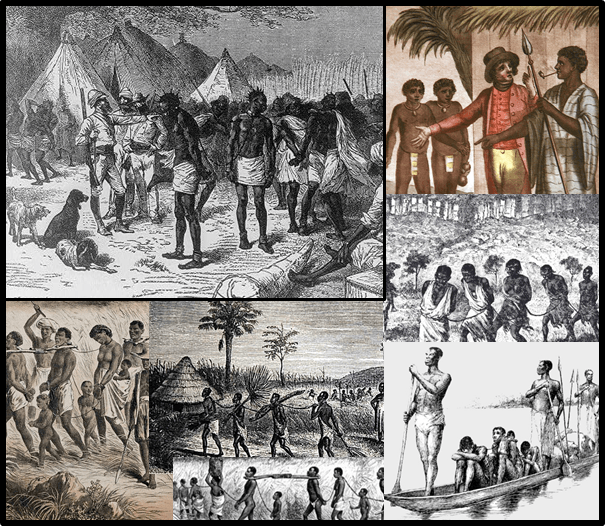
Europeans initially purchased slaves from the existing slave markets within these African kingdoms which were traditionally supplied by prisoners of war and locals convicted of crimes. Continued contact with European slave and gun traders helped to influence an increase of conflicts between several West African states leading them into a perpetual state of war which consequently committed a growing number of prisoners-of-war to the trans-Atlantic slave trade.
As the European demand for slave labor began to outstrip supply, slave raids became a more common practice across Western Africa. Raids were carried out by; groups of African and European slavers supplied with Europeans weapons; some African states who raided enemies; as well as Europeans who led their own slave raids. These practices began to depopulate the kingdoms, states, and empires of western Africa destabilizing the entire region.
PART 4
1500 to 1820 AD:
Trans-Atlantic Slave Trade Era
Between the years 1500 and 1820 more than 12.5 million African men, women, and children were loaded onto slave ships heading to the Americas. Approximately 2.5 million died along the way. Fewer than 500,000 were brought to North America (probably 410,000 and another 40,000 African born captives from the Caribbean) The bulk of the African captives came from just six regions highlighted on the above map of Africa (right).
The descriptions in the parentheses (00) match the images on the map.
FROM AFRICA TO NORTH AMERICA
(16) Senegambia
(green) an estimated 61,500 or 15% of the total (present day coast between Senegal and Gambia) – Included the empires of Jolof/Wolof, Fulu, Kaabu, kingdoms of Sine, Saloum, Cayor, Mossi, and Baol. They are also descendants of the Ancient Tichitt-Walata Civilization, Ghana, Mali, and Songhay Empires
(17) Windward Coast
(gray) 65,600 or 16% (most of present day Sierra Leone, Liberia, Ivory Coast)
– Included the Mandinka/Mandingo Kingdom and other smaller kingdoms.
(18) Gold Coast
(yellow) 53,300 or 13%(most of present day Ghana)
– Included the Akan States of Asante, Fente, Bono, and Akym, the Kong Empire and others.
(19) Bight of Benin
(red) 20,500 or 5% (present day Togo, Benin, and southwestern Nigeria)
– Included the Oyo Empire and the kingdoms of Benin and Dahomey and others who are descendants of the ancient Nok Civilization
(20) Bight of Biafra
(blue) 98,400 or 24% (most of present day Nigeria and Cameroon)
– Included the Kingdom of Nri, the Aro Confederacy, Kanem-Bornu Empires, and others who are likely partially descended from the Sao Civilization
(21) Congo/ Angola
(brown) 106,600 or 26% (present day Congo, Zaire, Angola, Namibia)
– Included the Kingdom of Kongo, Ndongo, Loango, Matamba, and several other nearby kingdoms
ARRIVAL IN NORTH AMERICA
African captives landed at just three regions in North America indicated on the above map of the United States (left).
(22) Georgia/ South Carolina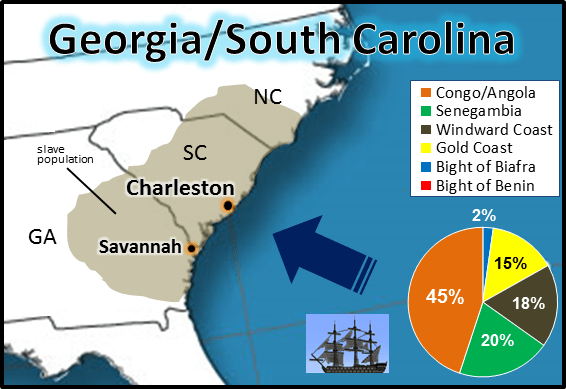
Over half – 234,000 or 52% – landed in Charleston, South Carolina which was the largest slave port on the North American shore. About 45% of the African captives who landed at this port were from the Congo/Angola region which were widely available in the Americas. About 20% came from the Senegambia region where many were originally rice farmers and therefore sought after for rice plantations eventuality becoming the Gullah people of the Georgia/ South Carolina coast.
Generally plantation owners from Georgia and South Carolina refused African captives from the Bight of Biafra who were largely from the Igbo ethnic group and descendants of the Nri Kingdom. It was believed that Igbos were more likely to revolt and commit suicide rather than be slaves because they had a tradition that valued freedom. Estimates of captives brought to Georgia/ South Carolina from each region:
- 45% from Congo/ Angola
- 20% Senegambia
- 18% Windward Coast
- 15% Gold Coast
- 2% Bight of Biafra
(23) Virginia/ Maryland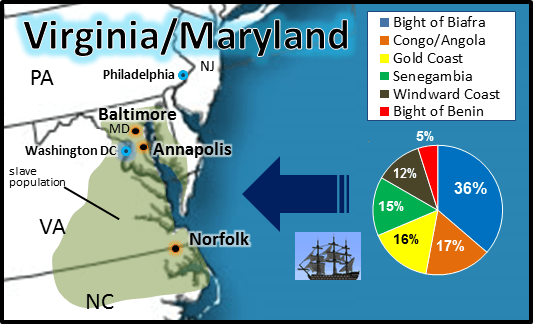
In direct contrast to Georgia and South Carolina, ships that supplied captives to Virginia and Maryland got the largest percentage (36%) of African captives from the Bight of Biafra. Estimates of captives brought to Virginia/ Maryland from each region:
- 36% Bight of Biafra
- 17% Congo/ Angola
- 15% from Senegambia
- 12% Windward Coast
- 16% Gold Coast
- 5% Bight of Benin
(24) Southern Louisiana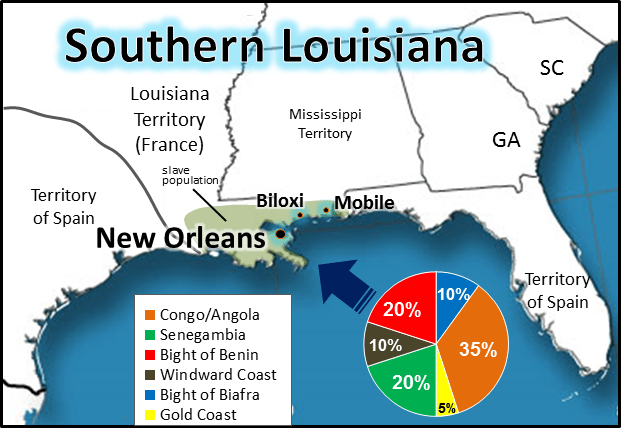
The French who controlled Louisiana imported a higher percent from Senegambia and Bight of Benin before the the United States obtained the land via the Louisiana purchase in 1803. Black New Orleans reflects some of the culture of the Yoruba ethnic group who are decedents of the Oyo Empire and Dahomey Kingdom near the Bight of Benin. Estimates into Louisiana from each region:
- 35% from Congo/ Angola
- 20% Senegambia
- 20% Bight of Benin
- 10% Windward Coast
- 10% Bight of Biafra
- 5% Gold Coast
African captives from the Gold Coast who were largely ethnic Akan people from the Asante Empire and nearby Akan states were preferred by all slave holders. However they were not as available as Congo/ Angola captives. Akan people came from societies who practiced a strict adherence to a hierarchical power structure. Many plantation owners believed this made them less likely to revolt.
The Trans-Atlantic Slave trade was officially outlawed in 1807 although some ships sailed illegally for many years after. In the year 1700 more than half (58%) of North America slaves were born in Africa but by 1820 more than 88% of slaves had been born in America. Slaves were forcibly encouraged not to pass on their African culture and identity which helped to solidify the notion of African Americans as a slave class. The African American population in 1820 was 1.7 million, 1.5 million of which were slaves.
PART 5:
1820 to 1860
U.S. Domestic Slave Trade Era
The Trans-Atlantic Slave Trade ended in 1807 which meant it was no longer legal to buy and sell slaves across the ocean or internationally. However slavery within the United States remained legal and even experienced a huge expansion during this time. In 1820 there were 1.7 million African Americans in the country and 1.5 million of them were slaves mainly concentrated in the Atlantic states and southern Louisiana.
Between 1800 and 1820 two events occurred changing the geography of slavery in America: the invention of the cotton gin and that Alabama, Mississippi, Louisiana, Arkansas, and Texas joined the union as slave-holding states. This lead to a surge in the domestic slave trade resulting in an increase of slaves from VA, MD, GA, SC, and Southern Louisiana being sold to MS, AL, TX, AR, and northern Louisiana.
During the length of the entire slave trade approximately 835,000 slaves were sold between plantations within the United States. A failed attempt by slave-holding states to preserve slavery by seceding from the United States resulted in the Civil War and the final abolition of slavery in America in 1865.
The descriptions in the parentheses (00) match the images on the map.
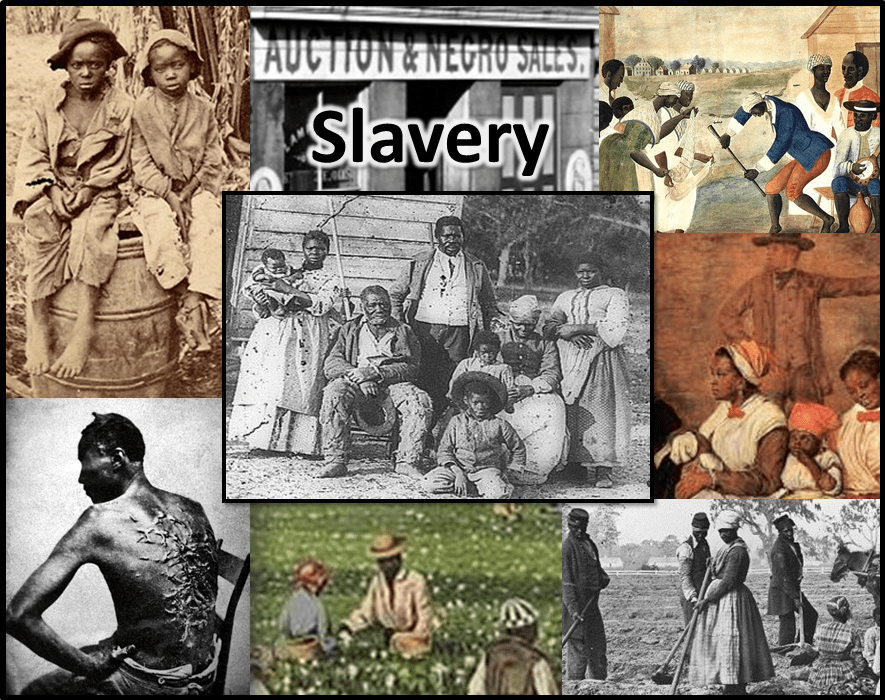
(25) Results from six different DNA studies show evidence that African Americans are on average 21% European. The widespread sexual exploitation of African American women during slavery is cited as a major reason for this as female slaves were considered property allowing for atrocities such as widespread rape to go unpunished.
Contrary to popular belief, so far DNA evidence reveals that African Americans are only 2% Native American. This contradicts what many African Americans have been told by older generations as an explanation for fair skin within most Black families. The stories of Native American Ancestry were very common and may have been an attempt to conceal the shame of the widescale rape of their ancestors.
The 1860 US Census, in its last official Census count before emancipation counted just under 4.5 million African Americans in which 4 million were slaves.
PART 6:
1865 to 1940
Black Settlements/ First Great Migration
Black Settlements
After emancipation a large percentage of newly freed African Americans remained on plantations as sharecroppers. However thousands of African American men and women opted, instead, to flee from their former plantations and created, occupied, and governed hundreds of new independent Black towns and settlements. Most Black settlements were unincorporated communities but about 80 Black towns were officially incorporated during this time.
A group of Black Settlements were located in Maryland and others were scattered throughout the deep south such as Grambling Louisiana, Tuskegee Alabama, and Mound Bayou Mississippi. But Oklahoma and Texas were home to a concentration of more than 70 Black settlements and towns. There was even a Black town as far west as California. In 1910, 89% of all African Americans still lived in the South, and 80% of them in rural areas.
The descriptions in the parentheses (00) match the images on the map.
(26) Mound Bayou, Mississippi
Mound Bayou, Mississippi exemplified the will and determination of formerly enslaved men and women who built these towns. In 1887 ex-slave Isaiah T Montgomery and his cousin Benjamin T. Green purchased undeveloped land on a rail line in the Mississippi Delta. With the help of twelve other freed slaves they cleared the land and erected the town of Mound Bayou. Like other Black towns Mound Bayou had grown into a self-sufficient city in the early 1900s with its own businesses including a cotton mill, four cotton gins, a bank, a public school system, a private school system, and a technical college. The State of Mississippi and the surrounding White residents resisted by bending laws to close down the Bank and trying to force Mound Bayou farmers to buy supplies from White suppliers. In response Mound Bayou businessmen went to court to reopen the bank and local farmers created a cooperative business for their supplies.
(27) Oklahoma Black towns and settlements
In Oklahoma from 1865 to 1920 more than 50 independent towns and settlements were created mostly on former Native American land opened up for settlement by the federal government. More Black towns and settlements were created in Oklahoma than any other state, thirteen of which still exist today. Boley, Oklahoma (pictured above) was the largest of these towns with over 4,000 residents in 1911. Boley had a nationally chartered bank, its own electric company, public and private schools, and two colleges. Just as he did with Mound Bayou Mississippi, Booker T. Washington visited, wrote, and talked about Boley in his speeches.
By 1910 African Americans who stayed behind on the old plantations began to grow frustrated with the system of sharecropping which had become in many cases, just another form of slavery. Also new Jim Crow legislation was being passed in the South further restricting many of the civil rights enjoyed briefly after emancipation. Rather than move into Black towns, a larger number of African Americans began moving North in what is now known as the First Great Migration into cities such as Chicago, Detroit, St Louis, and New York. There they created flourishing Black communities. Between 1910 and 1930 more than 1.5 million African Americans made this journey.
(28) Harlem, New York
Harlem, New York was an example of progress in the urban Black communities in northern cities. In 1904 real estate investor and savvy businessman Philip A. Payton, Jr. created the Afro-American Real Estate Company. With the help of Black investors from the National Negro Business League, he purchased two apartment buildings in Harlem and evicted its White tenets replacing them with Black tenants. This forced White owners to sell nearby buildings to Payton at much lower prices than they were originally worth. He continued to move Black renters into the buildings he owned and into others that he later leased, making Central Harem onto the Black community that later would be the home of the Harlem Renaissance. This is why Payton is sometimes acknowledged as the father of Harlem. Similar communities sprung up in cities of all sizes across the country in places such as Chicago, Cleveland, and Philadelphia and even in southern cities like Atlanta, Memphis, Birmingham, and Raleigh North Carolina.
Between emancipation and World War II, Black communities around the country were often plagued with Jim Crow legislation and race riots from neighboring White communities. In the South this occurred frequently when tensions between the races boiled over and often resulted in White mobs indiscriminately lynching African Americans, and in many cases, burning down and destroyed Black communities. In the North tensions often flared because of job competition and housing but had similar results.
(29) Black immigrants
Between 1899 and 1937 more than 140,000 Black immigrants came through United States ports mostly from the Caribbean or West Indian islands of the Bahamas, Jamaica, Barbados, Saint Vincent, Saint Lucia, Grenada, and Dominica. Popular destinations were New York, Boston, and Florida. At one point close to one third of Black Central Harlem was from the Caribbean. Black Caribbeans tended to be overrepresented as Black business owners and members of the middle class. At times, this caused tension between them and the African American population. Another wave of about 40,000 Black immigrants entered the United States from the Caribbean during World War II as laborers working wherever they were needed for the war effort. Second and third generation Black Caribbeans usually integrated with African Americans but also identified strongly with their Caribbean or West Indian heritage.
The Great Depression of the 1930s sealed the fate of many Black settlements that were unable to survive economically. Residents abandoned many of these communities to find work, food, and shelter elsewhere. Few settlements survived on their own and others were annexed by nearby cities. The depression also slowed down the migration from the South. Despite these setbacks the African American population of the United States in 1940 had grown to 12.9 million.
Oklahoma Towns Video: http://www.okhistory.org/historycenter/blacktowns/ssjones.mp4
PART 7:
1941 to 1970
The Second Great Migration
After the Great Depression, millions of African Americans began escaping the Jim Crow South again. More than 5 million African Americans moved to cities in the North and on the West Coast in what is known as the Second Great Migration. This migration tended to follow the pattern of the First Great Migration along the rail lines; therefore, one may find that certain cities in the North have Black populations that come from the same areas in the South. This is why so many African Americans in New York have family in Virginia, Georgia, North and South Carolina while many others from Detroit have family in Alabama, and those in Chicago tend to have roots in Mississippi. For most, the South was considered their homeland because they could no longer trace their African identity; it had long been erased during the institution of American slavery.
The descriptions in the parentheses (00) match the images on the map.
(30) The 1950s marked the beginning of the Civil Rights era. African American life in Montgomery, Alabama had become typical of the Jim Crow South. However, in 1955 a woman named Rosa Parks refused to give up her seat to a White man as required by Montgomery city ordinance. This sparked the famous Montgomery bus boycott headed by Rev Martin Luther King Jr. where 40,000 Black bus patrons in an economic protest, refused to ride the bus for 381 days until the system was integrated after a Supreme Court decision. Despite the hard fought gains in civil justice, African Americans were still leaving the South in large numbers.
(31) Migrating North: Detroit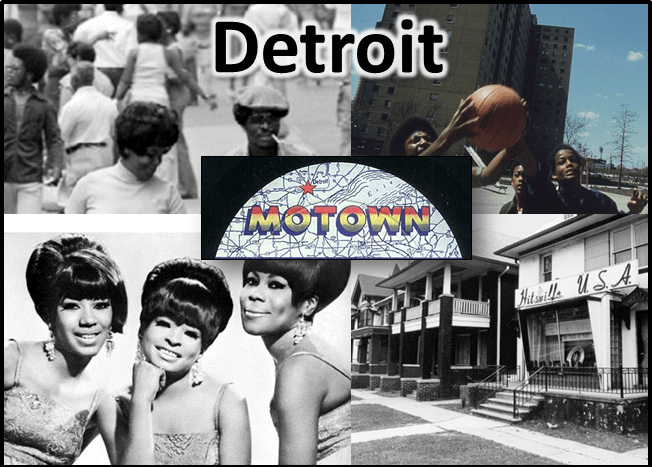
As African Americans moved north, the Black population in many northern cities like Detroit exploded during and after World War II due to available industrial jobs. Between 1940 and 1950, more than 66% of the Black population in Detroit was born outside of the area, with most born in the South. Although there were no Jim Crow laws in Detroit, from 1950 to 1970 racial segregation in the metro area increased as the White population moved to suburbs. It was during this time period that Detroit was said to have one of the largest Black middle-class communities in the nation and Motown Records brought Detroit international fame.
(32) Moving West: Los Angeles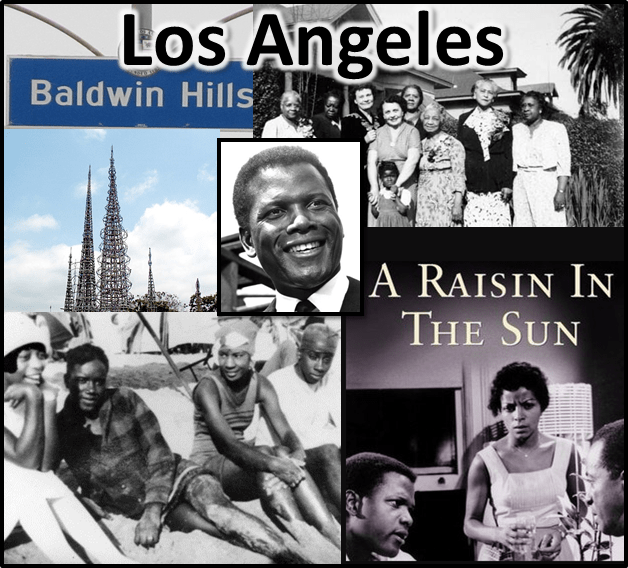
In 1940, Los Angeles had a black population of 63,774; more than all other western cities combined. During the 1940s about 140,000 African Americans began arriving from the South and Midwest to fill jobs in the newly opened factories. By 1960, Los Angeles had the fifth largest black population in the US, larger than any city in the South. This also had an affect on Hollywood which began producing more well-meaning Black films like ‘A Raisin in the Sun’ and television shows like I, Spy, Julia, and The Bill Cosby Show which offered a more three-dimensional portrayal of African Americans in entertainment than in previous decades.
The industrial North and West Coast also provided union jobs for laborers and brought many African American families into the middle class became able to afford to send their children to college. By 1960, 40 percent of all African Americans lived outside the South, and 75% lived in cities.
The Civil Rights Era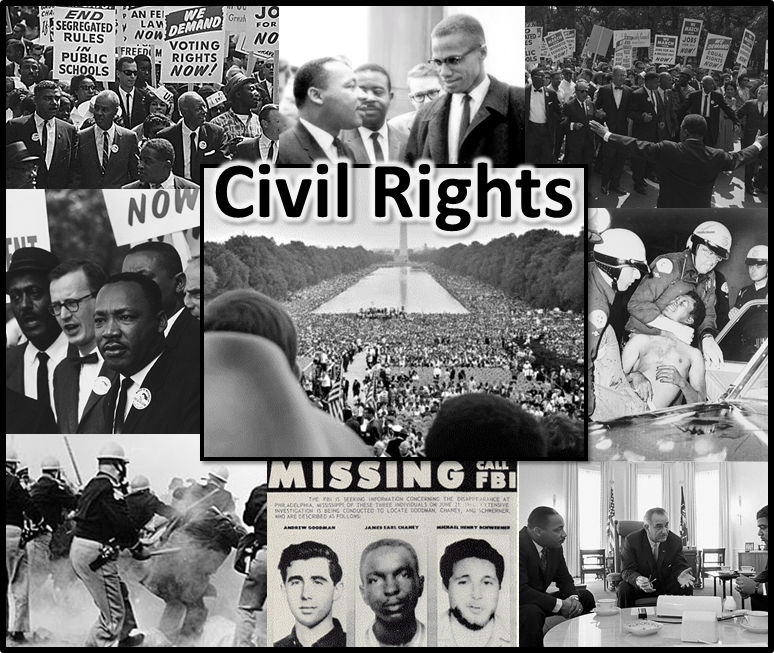
lasted from the 1950s through the 1960s. During this period, millions of African Americans from Montgomery, Alabama to Chicago fought for civil rights to gain the privilege to vote, desegregate the schools, end housing and job discrimination, and end the policy of “separate but equal” public and private services. The success of the protests and the new legislation was almost overshadowed by widespread rioting that occurred in dozens of cities in the North and on the West Coast. The effect of the Civil Rights era would lead to dramatic changes for Black America in the coming decades. By 1970, 47 percent of all African Americans lived outside the South and more than 80 percent lived in urban areas. In 1970 the African American population was 22.6 million.
PART 8:
1970 to 2000
The NEW Great Migration
After the civil rights era the African American population began a noticeable split. Black consumers started spending more of their money at White owned businesses resulting in the demise of many Black owned businesses. Also, many Middle class and upwardly mobile African Americans who would have opened businesses were, instead, taking advantage of newly available education and employment opportunities within corporate America and the government. These combined factors added to the lack of business and job creation from within the Black community because getting a good job was viewed as more attainable and financially stable than creating a business.
With the end of housing discrimination policies White suburbs all across America began to experience an increase of African Americans. Most suburbs remained overwhelmingly White while some in large cities became majority Black middle class neighborhoods.
(33) For example during this suburbanization period (1970-2000) many middle class African Americans left the city limits of Detroit. By 2000 African Americans made up almost half of the total population growth in the Detroit suburbs. From 1990 to 2000 the Black population in the city of Detroit decreased for the first time in history. Poverty in the city increased and became more concentrated. The city lost much of its tax base and more than half of its total population and today it is widely used as the prime example of urban decay. This same pattern was repeated all across America. As of 2002, ninety percent of the Black population in metropolitan Detroit resided in either Detroit or four of its suburbs.
(32) Growing Black Middle – Class
During the 1980s the southern half of Suburban Atlanta became a big destination for African Americans from across the country who were looking for a good neighborhoods near the fast growing city of Atlanta. Suburban Black middle-class neighborhoods began filling undeveloped land all throughout the southern half of Metro Atlanta in DeKalb, South Fulton, and Clayton Counties. Because of the lack of job development in the southern suburbs most still had to commute downtown or to job centers on the opposite side of Atlanta (north).
Despite this many have considered the Atlanta Metro to be the New Black Mecca, allegedly replacing Harlem as the African American center of business and culture and beginning to eclipse Los Angeles and New York as the center of African American entertainment. The Atlanta metropolitan Black population would become the second largest in the nation by 2010 with 1.8 million African Americans surpassing Chicago and coming in second to New York.
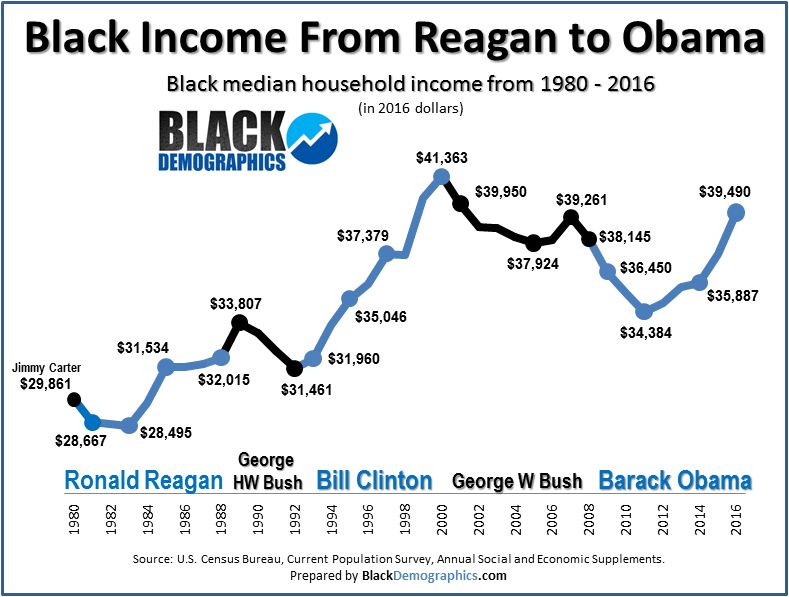
Majority Black middle-class suburbs also sprung up outside of other major cities including Washington DC (Prince George’s County, Maryland), Dallas (DeSoto, Cedar Hill), Chicago (Hazel Crest), Charlotte, and St Louis (Black Jack). Despite having large concentrations of Black middle-class residents, these communities still lacked an economic base of business development to help support infrastructure, job growth, health and community services, as well as other basic forms of commercial development. They were often located too far from areas with job and infrastructure growth and required lengthy commutes.
(34) For example while the Black Suburbs of DeSoto and Cedar Hill were growing south of Dallas, corporations were busy creating jobs and expanding infrastructure north of Dallas. (33) The Black suburbs of Prince George’s County MD was expanding east and further southeast of Washington DC, while most corporate business development was growing north of DC and west of DC in Virginia. The same pattern exists in Chicago, Houston, St Louis, and other cities which placed the biggest corporate investment on the opposite side of the metropolitan areas from the Black middle class.
As the Rust Belt cities of the old industrial age such as Detroit, Cleveland, Milwaukee, and Pittsburgh, etc. continued to decline during the 80s and 90s, middle-class African Americans who did not move to local suburbs began migrating to suburbs of sunbelt cities like Atlanta, Charlotte, Houston and Phoenix which offered more job opportunities and a better quality of life.
Black Poverty
The flight of the Black middle class left behind even poorer more isolated and less educated Black communities in traditionally Black neighborhoods with crumbling infrastructures in cities and towns all across America. By 2014 23% percent of Black families and 37% of single-parent Black families lived below the poverty level. They were vulnerable to a growing drug epidemic and the so-called “War on Drugs” which lead to a wave of mass incarceration policies including “tough on crime” legislation passed on every level of government. The result was an increased use of heavy handed policing particularly focused on Black men.
As a result an alarming number of Black men have been removed from the workforce and deemed unemployable because of drug related non-violent felony crime records. Before 1960 African Americans were more likely to be married than Whites but by 2010 only 32% of African Americans were married compared to 52% of all Americans. This greatly affected the extremely poor and a large number of now single income middle-class Black families who actually had been surviving only a pay period away from the poverty line.
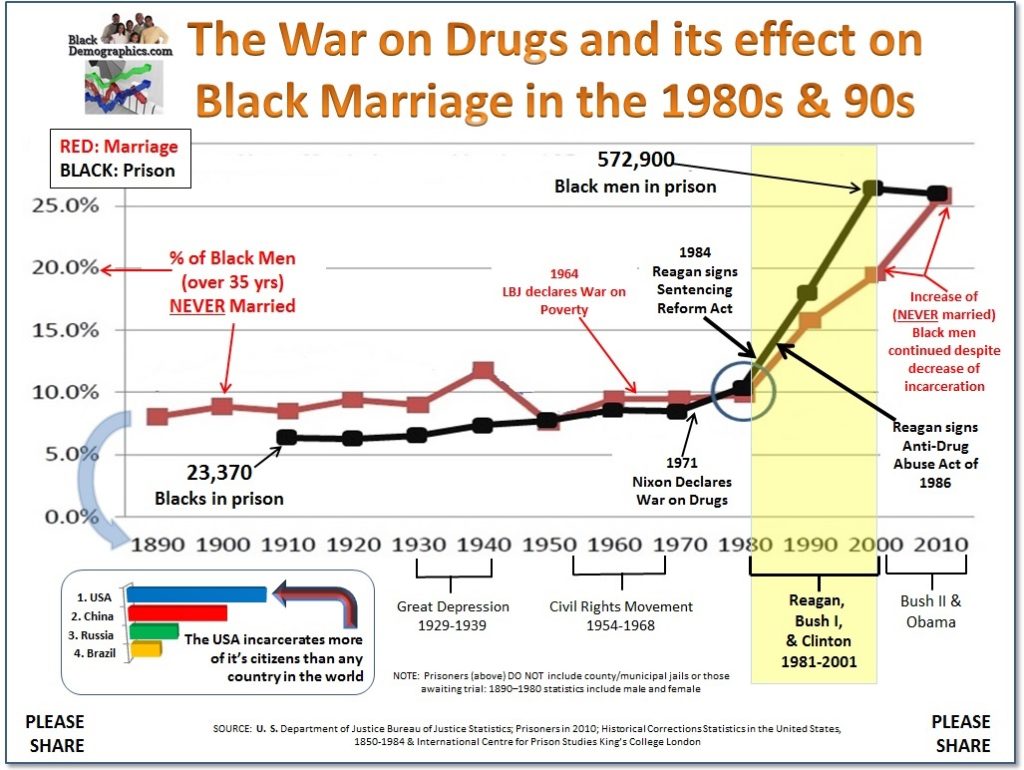
For many African Americans the era between 1970 and 2000 will be seen as a time of advancement and prosperity; for many others it will be viewed as a time of cyclical poverty and mass incarceration of Black men who, as a result, were less able to help lead their poorer communities. At the same time they became less of a factor in the future of middle class Black families. From 1970 to 2000 the Black population grew from 22.6 million to 36.4 million.
Density of the Black Population in 2000
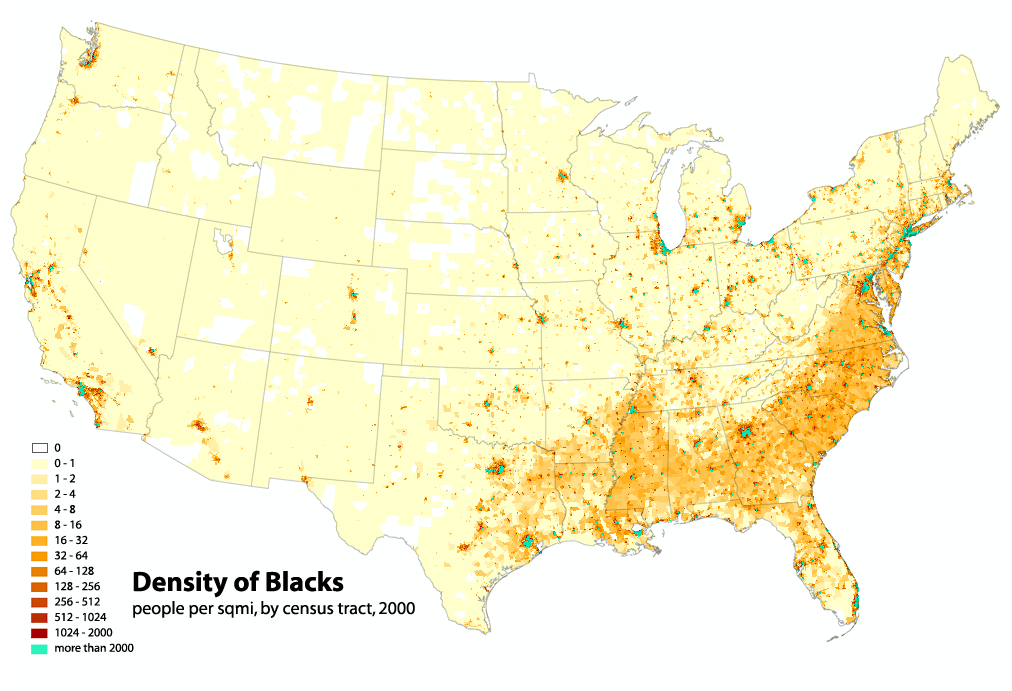
After 2000
(36) Between 2000 and 2014 more than 1 million immigrants from sub-Saharan Africa came to the United States mainly from Nigeria, Ghana, Kenya, Ethiopia, and Somalia. This was the largest number of Africans coming to the U.S. since the trans-Atlantic slave trade. Most have settled in metropolitan areas of New York, Washington DC, Atlanta, Houston, Minneapolis, Los Angeles, and Dallas where they tend to be dispersed in non-Black neighborhoods. African immigrants tend to have a higher than average socioeconomic status and are literally the most educated of all immigrants to the United States from anywhere else in the world. In 2013 an estimated 3.8 million or 8.7% of the Black population were foreign born from Africa and the Caribbean. This number is expected to rise to 16% by 2060.
The Great Recession
The economic recession of 2008 set African American families back more and longer than others. Some of the highest home foreclosure rates happened in the majority Black middle-class suburbs. African Americans are the only group that has not recovered fully from the recession.
Recent Rise in Activism
With the help of mobile phone videos, social media, and nationwide protests, a resurgence of a 1960s style civil rights movement began in 2015. This movement is mainly focused on ending police brutality, discrimination, and mass incarceration. A much smaller lesser-known economic movement of Black business ownership, support, and job creation is also underway. So far, this initiative has failed to gain steam and yield community-impacting results with the majority of the African American community.
Conclusion
African Americans have a history that goes back four thousand years, not “four hundred years” – which is a frequently used phrase when discussing Black history. That means for at least 3,600 years our ancestors controlled the societies, governments, militaries, and economies, of Western Africa. All of this took place before 400 years of being sold across the ocean, enduring slavery, mass rape, racial oppression. The last 400 years have forcibly merged the Black population into one people whose knowledge of its own history had been lost and forgotten.
Since the end of slavery African Americans have gone to great lengths to become a part of the American Dream – with many successes as well as many failures. Today African Americans have failed to fully integrate as a whole into American society and have yet to create an economic job creation engine that will sustain Black communities. Despite the growth of the Black middle-class Black wealth remains very low ($5,600) compared to that of White Americans($113,000). Today African American families are more fragile than ever because they are more reliant on single parental incomes, have few investments, and own few assets.
African America – A Powerful Nation
Despite all of this the African American population boasts a spending power of more than 1 trillion dollars annually. If Black America were its own nation it would be a nation of 45 million and would rank 31st in size on earth with a life expectancy higher than 103 other countries. Substituting income for GDP, it would have a GDP higher than all South American countries, all African countries, and higher than most Asian countries. The chart below created using GapMinder’s Socio-Economic World Map shows you what that would look like.
CLICK IMAGE TO ZOOM
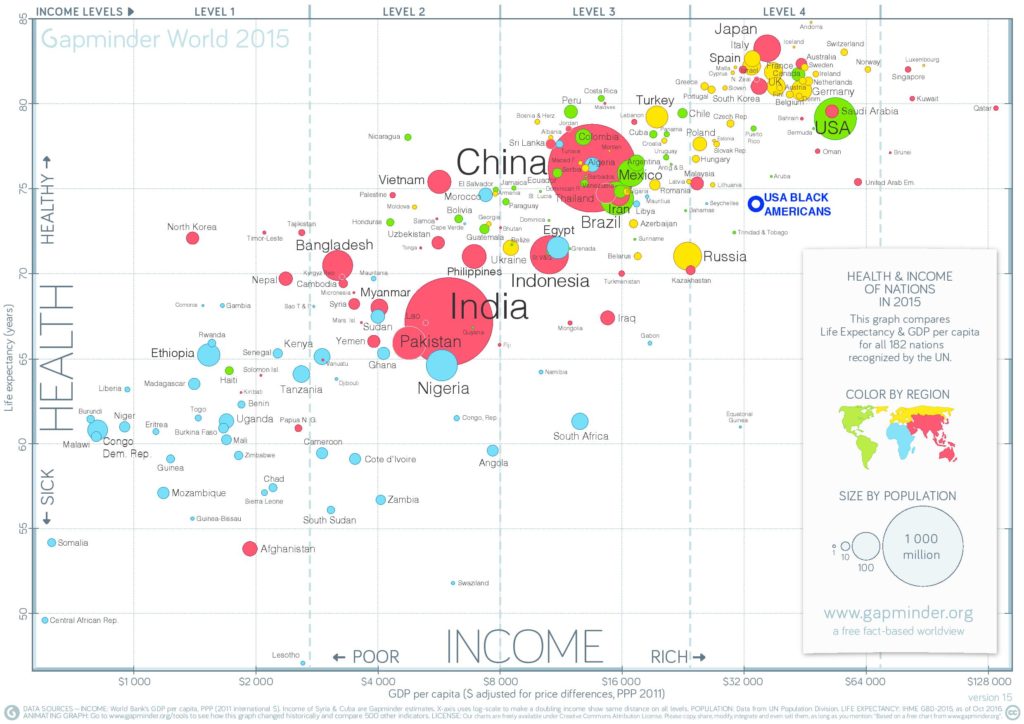
Therefore the African American community is positioned above most other populations in the world with a unique opportunity to gather its strengths and build a stronger community with not only a great history but also a greater future.
This is a post that must be shared. Feel free to help make this post viral. Also make it better by submitting corrections and/or suggestions to emailme@onlymoveforward.com
Thank You
=================================================
Sources
BOOKS
Exchanging Our Country Marks: The Transformation of African Identities in the Colonial and Antebellum South – Gomez, Michael A..
Finding a Place Called Home: A Guide to African American Genealogy and Historical Identity – by Dee Parmer Woodtor Ph.D
The History of Black Business in America: Capitalism, Race, and Entrapenuership – Juliet E.K. Walker
The Politics of Heritage in Africa – edited by Derek R. Peterson, Kodzo Gavua, Ciraj Rassool
Mission from Cape Coast Castle to Ashantee, with a statistical account of that kingdom, and geographical notices of other parts of the interior of Africa – Bowdich, T. Edward (Thomas Edward), 1791-1824
From Slavery to Freedom: A History of Negro Americans – John Hope Franklin & Alfred A. Moss, Jr
Life Upon these Shores: Looking at African American History 1513-2008 – Henry Louis Gates, Jr
ONLINE RESOURCES
Yale Lecture Nok Culture: https://youtu.be/7ja_BMeBeiQ
academia.edu: academia.edu/1615727/Tichitt-Walata_and_the_Middle_Niger_evidence_for_cultural_contact_in_the_second_millennium_Be
ushistory.org: ushistory.org/civ/7a.asp
ancient.eu: ancient.eu/Ghana/
familysearch.org
The Trans-Atlantic Slave Trade Database: Slavevoyages.org
Historywiz: historywiz.com/oyo.html
Britannica: britannica.com
The Slave Rebellion Website: slaverebellion.org
Yoruba Reference: yorupedia.com
Afropedia: sites.google.com/site/afropedia/
Historum – History Forums: historum.com
The History Files: historyfiles.co.uk
Our Afrikan Heritage Magazine: afrikanheritage.com
The Edo Delta Movement: edodeltamovement.wordpress.com/
Antiquity, Department of Archaeology Durham University, England: antiquity.ac.uk/projgall/magnavita/
Historian Lincoln A. Mullen: lincolnmullen.com/projects/slavery/
Oklahoma Towns Video: www.okhistory.org/historycenter/blacktowns/ssjones.mp4
The African-American Migration Experience: inmotionaame.org
blackpast.org
Wikipedia
Ife and Benin Art: youtu.be/TKG6Ei505GQ
ARTICLES
theroot.com/articles/history/2013/02/how_mixed_are_african_americans/
smithsonianmag.com/history/maps-reveal-slavery-expanded-across-united-states-180951452/
cambridge.org/core/journals/journal-of-economic-history/article/div-classtitlespan-classitalicquantitative-estimates-of-the-united-states-interregional-slave-trade-18201860spandiv/A0194C0EB3341282AA0C4B848CDE9A0A
washingtonpost.com/wp-srv/inatl/longterm/richburg/richbrg1.htm
academia.edu/28886529/Displaying_Loot._The_Benin_objects_and_the_British_Museum
richardlander.org.uk/benin_bronzes.html
atsentertainment.com/oyo-yoruba-empire-structural-component/
amoeba.com/blog/2012/01/eric-s-blog/a-brief-and-by-no-means-complete-history-of-black-los-angeles-happy-black-history-month-.html
america.aljazeera.com/articles/2015/8/4/once-forgotten-oklahomas-historic-all-black-towns-find-renewed-interest.html
washingtonpost.com/lifestyle/style/a-list-of-well-known-black-towns/2015/03/27/9f21ca42-cdc4-11e4-a2a7-9517a3a70506_story.html?utm_term=.df2e65a60de7
pewresearch.org/fact-tank/2015/11/02/african-immigrant-population-in-u-s-steadily-climbs/
washingtonpost.com/local/black-immigration-is-remaking-us-black-population-report-says/2015/04/09/ded49c58-de29-11e4-a1b8-2ed88bc190d2_story.html?utm_term=.a108af166d6c
migrationpolicy.org/article/sub-saharan-african-immigrants-united-states
UNIVERSITY COLLECTIONS
digitalcollections.nypl.org/collections/the-earth-and-its-inhabitants-africa#/?tab=about
http://www.cus.wayne.edu/media/1356/aawork8.pdf
beinecke.library.yale.edu/collections/highlights/solomon-sir-jones-films-1924-1928
digital.library.wayne.edu/digitalcollections
COMMUNITY DISCUSSION SITES
nairaland.com/1249503/interesting-images-precolonial-early-colonial/11
thecoli.com/threads/indigenous-african-architecture.356433/
ukpuru.tumblr.com/post/111409313867/benin-city-west-africa-1660sd-o-dapper
foreverblackeffusion.wordpress.com/category/africa/
slideshare.net/feelthechange/a-taste-of-ancient-africa-south-of-egypt
===========================
FAIR USE NOTICE: This article may at times present copyrighted material, the use of which might not always been specifically authorized by the copyright owner. Such material is made available in an effort to advance understandings of African and African American History. The author believes that this constitutes a “fair use” of any such copyrighted material as provided for in section 107 of the U. S. Copyright Law. In accordance with Title 17 U.S.C. Section 107, this article is published solely for research and educational purposes.
Disclaimer: All material on this website is posted in accordance with the limitations set forward by the Digital Millennium Copyright Act (DMCA). If a documented copyright owner so requests, their material will be removed from published display, although the Author reserves the right to provide linkage to that material or to a source for that material


